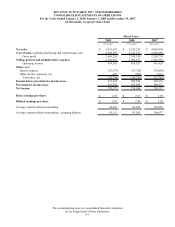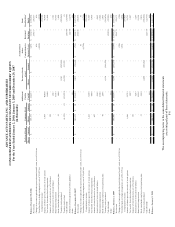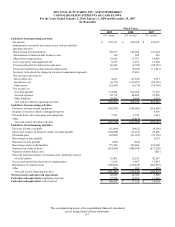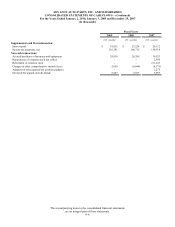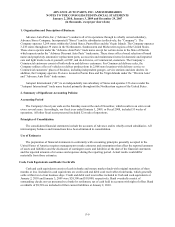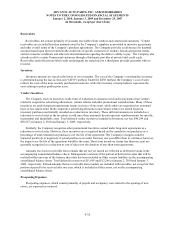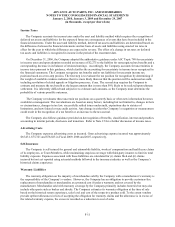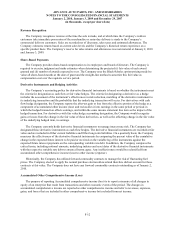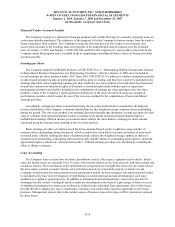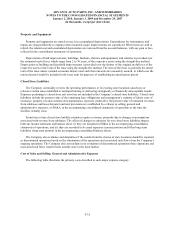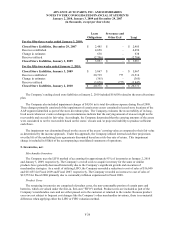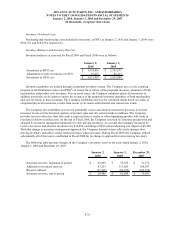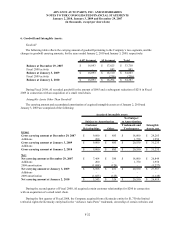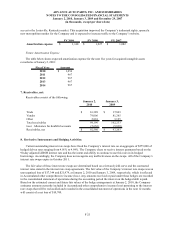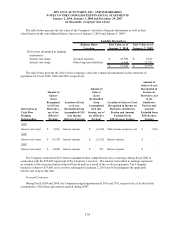Advance Auto Parts 2009 Annual Report Download - page 68
Download and view the complete annual report
Please find page 68 of the 2009 Advance Auto Parts annual report below. You can navigate through the pages in the report by either clicking on the pages listed below, or by using the keyword search tool below to find specific information within the annual report.ADVANCE AUTO PARTS, INC. AND SUBSIDIARIES
NOTES TO THE CONSOLIDATED FINANCIAL STATEMENTS
January 2, 2010, January 3, 2009 and December 29, 2007
(in thousands, except per share data)
.
F-15
Property and Equipment
Property and equipment are stated at cost, less accumulated depreciation. Expenditures for maintenance and
repairs are charged directly to expense when incurred; major improvements are capitalized. When items are sold or
retired, the related cost and accumulated depreciation are removed from the account balances, with any gain or loss
reflected in the consolidated statements of operations.
Depreciation of land improvements, buildings, furniture, fixtures and equipment, and vehicles is provided over
the estimated useful lives, which range from 2 to 30 years, of the respective assets using the straight-line method.
Depreciation of building and leasehold improvements is provided over the shorter of the original useful lives of the
respective assets or the term of the lease using the straight-line method. The term of the lease is generally the initial
term of the lease unless external economic factors exist such that renewals are reasonably assured, in which case the
renewal period would be included in the lease term for purposes of establishing an amortization period.
Closed Store Liabilities
The Company continually reviews the operating performance of its existing store locations and closes or
relocates certain stores identified as underperforming or delivering strategically or financially unacceptable results.
Expenses pertaining to closed store exit activities are included in the Company’s closed store liabilities. Closed store
liabilities include the present value of the remaining lease obligations and management’s estimate of future costs of
insurance, property tax and common area maintenance expenses (reduced by the present value of estimated revenues
from subleases and lease buyouts) and new provisions are established by a charge to selling, general and
administrative expenses, or SG&A, in the accompanying consolidated statements of operations at the time the
facilities actually close.
From time to time closed store liability estimates require revisions, primarily due to changes in assumptions
associated with revenue from subleases. The effect of changes in estimates for our closed store liabilities impact
both our income statement and balance sheet: (i) they are included in SG&A in the accompanying consolidated
statements of operations, and (ii) they are recorded in Accrued expenses (current portion) and Other long-term
liabilities (long-term portion) in the accompanying consolidated balance sheets.
The Company also evaluates and determines if the results from the closure of store locations should be reported
as discontinued operations based on the elimination of the operations and associated cash flows from the Company’s
ongoing operations. The Company does not include in its evaluation of discontinued operations those operations and
associated cash flows transferred to another store in the local market.
Cost of Sales and Selling, General and Administrative Expenses
The following table illustrates the primary costs classified in each major expense category:


